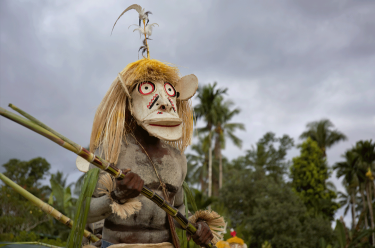The APT8 Conference was held immediately after the opening weekend celebrations and invited artists, researchers, and curators from Australia, Asia and the Pacific to address some of the key conceptual threads within ‘The 8th Asia Pacific Triennial of Contemporary Art’ currently on view at QAG and GOMA until 10 April 2016.
The triennial’s eighth edition emphasises the role of performance in recent art, with live actions, video, kinetic art, figurative painting and sculpture exploring the use of the human form to express cultural, social and political ideas, and the central role of artists in articulating experiences specific to their localities.
APT8 includes more than 80 artists and groups and two focus projects are the result of in-depth research and ongoing exchange with the region. Yumi Danis (We Dance) presents the vitality and complexity of performance in the cultures of some of our nearest neighbours: Papua, Papua New Guinea, Fiji, Solomon Islands, Vanuatu and New Caledonia. Kalpa Vriksha: Contemporary Indigenous and Vernacular Art of India looks at the breadth and vibrancy of Indigenous and vernacular art from regions of India. Also featured are site-specific installations by artists from UAE/Iran, India, South Korea, Myanmar, Australia and New Zealand.
Each session featured three presentations by special guests, followed by a moderated discussion. These sessions and the special performance by Yamani are now available to view.
Session 1 – Moving and Shaking
For much of this part of the world, social change is not simply an aspiration of politically-minded artists; it is a given, the very context in which art takes place. How do artists respond to conditions of flux and uncertainty, and in what ways might they participate in it? How specific to art-making are geographical and cultural conditions at a time of rapid change? Is there a relationship between the drivers of social change in Asia and the Pacific and the types of art being made in the region?
Session 2 – Vital Signs
There are distinct relationships between museum collections and the activities of daily cultural production. Performance, design, craft, folk, vernacular and ritual objects operate in distinct cultural contexts with highly specific meanings and functions. By bringing vernacular or ritual objects, or even performance and other ephemeral practices, into the museum, what processes of critique are enacted? How does their exhibition in a museum or gallery context affect their interpretation? Perhaps more pointedly, what might they offer the discourses and practices of contemporary art?
Session 3 – Bodies Politic
Recent practice in the Asia-Pacific has seen renewed attention to the symbolic potential of the human body. In what ways are bodies utilised in contemporary practice, particularly with regard to contested issues, sites and histories? As sensory registers of mortality and desire, do bodies possess some kind of political autonomy that empowers them as instruments of social and institutional critique?
Special Event – Screening and performance
Tusalava is a ten minute film made by Len Lye in 1929 and comprises of 7.000 drawings which he photographed to create this stop animation. These drawings were influenced by Modernism but also Maori, Aboriginal and Samoan art. Yamani is a community project between the Queensland Indigenous Languages Advisory Committee (QILAC) and Wantok Musik. The group features indigenous women from across Queensland, Australia singing in their traditional languages. The Yamani group responded to Len Lye’s Tusalava 1929 with an original composition featuring Aboriginal and Torres Strait Islander languages from around Queensland, Australia. The languages that featured in the composition were Warrgamay, Kalaw Kawaw Ya, Butchulla, Gunggari and Yugambeh. The music was by Faith Baisden and reflected on the instinct for connection and its counterbalance in the struggle for control
The APT8 Conference held on Monday 23 November 2015 was presented in association with Brisbane Consortium for the Visual Arts.
The APT8 Conference was held in conjunction with the annual 2015 Art Association of Australia and New Zealand conference on Tuesday 24 and Wednesday 25 November 2015.
The Asia Pacific Triennial of Contemporary Art (APT)
is the Gallery’s flagship exhibition focused on the work of Asia, the Pacific and Australia.
21 November 2015 – 10 April 2016
Exhibition Founding Sponsor: Queensland Government
Exhibition Principal Sponsor: Audi Australia

